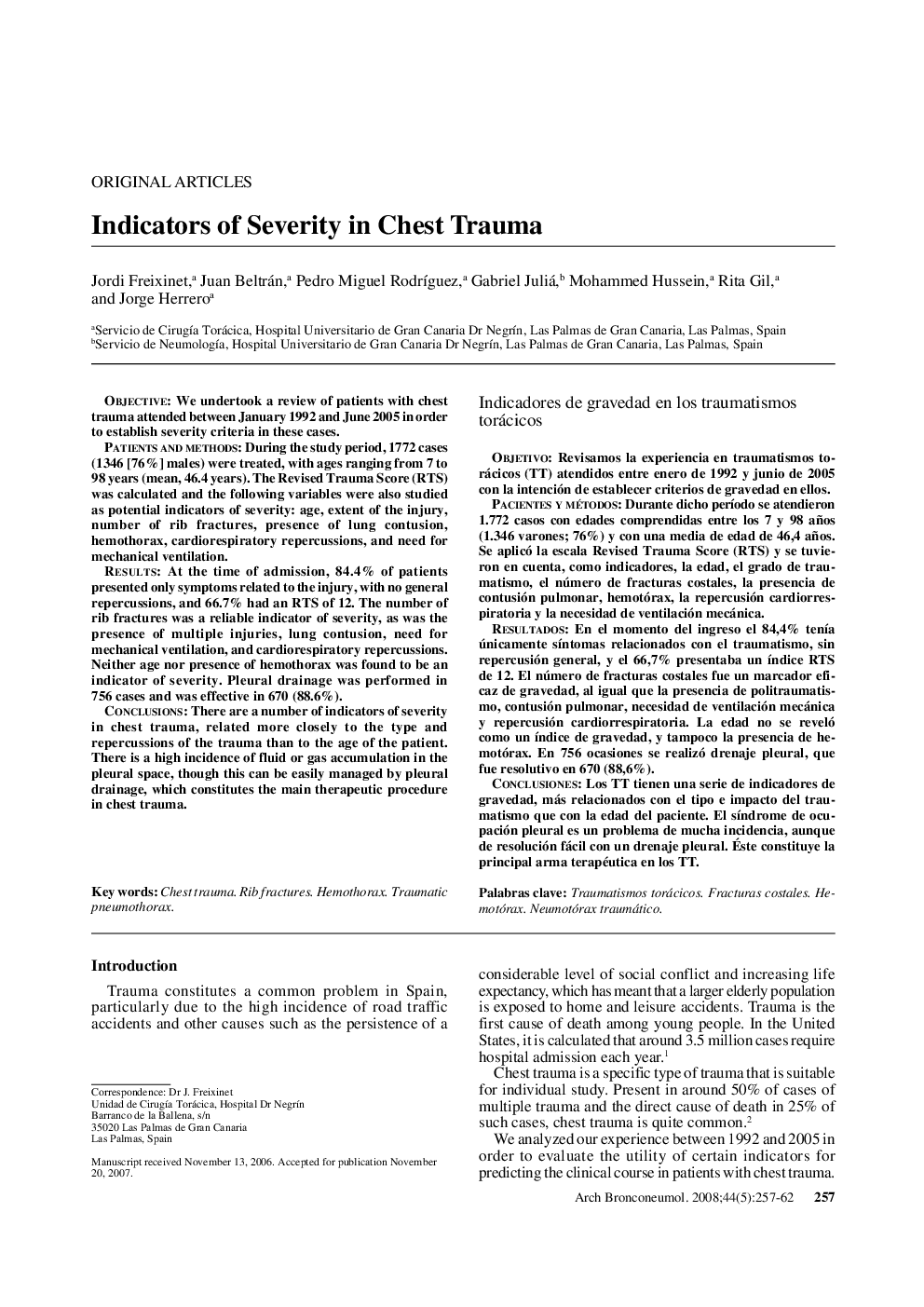| Article ID | Journal | Published Year | Pages | File Type |
|---|---|---|---|---|
| 4206829 | Archivos de Bronconeumología (English Edition) | 2008 | 6 Pages |
ObjectiveWe undertook a review of patients with chest trauma attended between January 1992 and June 2005 in order to establish severity criteria in these cases.Patients and methodsDuring the study period, 1772 cases (1346 [76%] males) were treated, with ages ranging from 7 to 98 years (mean, 46.4 years). The Revised Trauma Score (RTS) was calculated and the following variables were also studied as potential indicators of severity: age, extent of the injury, number of rib fractures, presence of lung contusion, hemothorax, cardiorespiratory repercussions, and need for mechanical ventilation.ResultsAt the time of admission, 84.4% of patients presented only symptoms related to the injury, with no general repercussions, and 66.7% had an RTS of 12. The number of rib fractures was a reliable indicator of severity, as was the presence of multiple injuries, lung contusion, need for mechanical ventilation, and cardiorespiratory repercussions. Neither age nor presence of hemothorax was found to be an indicator of severity. Pleural drainage was performed in 756 cases and was effective in 670 (88.6%).ConclusionsThere are a number of indicators of severity in chest trauma, related more closely to the type and repercussions of the trauma than to the age of the patient. There is a high incidence of fluid or gas accumulation in the pleural space, though this can be easily managed by pleural drainage, which constitutes the main therapeutic procedure in chest trauma.
ObjetivoRevisamos la experiencia en traumatismos to-rácicos (TT) atendidos entre enero de 1992 y junio de 2005 con la intención de establecer criterios de gravedad en ellos.Pacientes y métodosDurante dicho período se atendieron 1.772 casos con edades comprendidas entre los 7 y 98 años (1.346 varones; 76%) y con una media de edad de 46,4 años. Se aplicó la escala Revised Trauma Score (RTS) y se tuvieron en cuenta, como indicadores, la edad, el grado de traumatismo, el número de fracturas costales, la presencia de contusión pulmonar, hemotórax, la repercusión cardiorrespiratoria y la necesidad de ventilación mecánica.ResultadosEn el momento del ingreso el 84,4% tenía únicamente síntomas relacionados con el traumatismo, sin repercusión general, y el 66,7% presentaba un índice RTS de 12. El número de fracturas costales fue un marcador eficaz de gravedad, al igual que la presencia de politraumatismo, contusión pulmonar, necesidad de ventilación mecánica y repercusión cardiorrespiratoria. La edad no se reveló como un índice de gravedad, y tampoco la presencia de hemotórax. En 756 ocasiones se realizó drenaje pleural, que fue resolutivo en 670 (88,6%).ConclusionesLos TT tienen una serie de indicadores de gravedad, más relacionados con el tipo e impacto del traumatismo que con la edad del paciente. El síndrome de ocupación pleural es un problema de mucha incidencia, aunque de resolución fácil con un drenaje pleural. Éste constituye la principal arma terapéutica en los TT.
